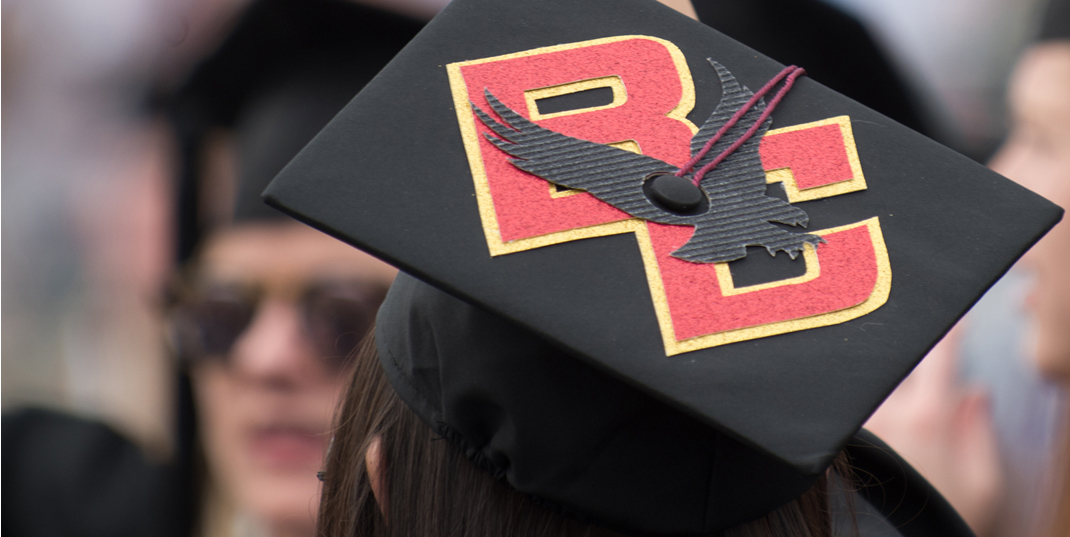Boston College Commencement in 2019.
Boston College has the third-best graduation rate in the country for Pell Grant recipients, a significant benchmark for the University’s efforts to enroll first-generation, low-income students who have been historically under-represented in higher education.
The 96 percent Pell Grant graduation rate BC achieved this past academic year ranks only behind Cal Tech and Princeton, according to data in the recent U.S. News & World Report survey of colleges and universities.
Federal Pell Grants are awarded to undergraduates who display extreme financial need, as demonstrated in the difference between the cost of attending a specific college or university and the expected family contribution. Pell recipients represent approximately 14 percent of the Boston College student population, according to the University’s Office of Enrollment Management.
“ This achievement represents Boston College at its best,” said Mahoney. “It’s the result of collaborations between various offices, organizations, and individuals across and beyond the campus, all of which support the hard work of our Pell Grant-receiving students to realize their dream of a high-quality college education. ”
Vice Provost for Enrollment Management John L. Mahoney said the graduation rate for Pell recipients at BC typically has been high, especially in recent years: 91 percent last year and 90 percent in 2018. For context, Mahoney pointed to the University’s overall six-year graduation rate—a reporting standard among all American colleges and universities—of 94 percent; BC ranks 21st among national universities in overall retention and graduation.
“This achievement represents Boston College at its best,” said Mahoney. “It’s the result of collaborations between various offices, organizations, and individuals across and beyond the campus, all of which support the hard work of our Pell Grant-receiving students to realize their dream of a high-quality college education.”
Among the vital partnerships, he explained, are those between Office of Undergraduate Admission staff and various community-based organizations (CBOs) across the country such as Upward Bound, New Jersey SEEDS (Scholars, Educators, Excellence, Dedication, Success), and the Wight Foundation that encourage and support first-generation, low-income high school students of academic promise in pursuing higher education.
“In the communities served by these organizations, schools tend to have high counselor-to-student ratios that make it difficult to offer college guidance to lower-income students and their families,” Mahoney said. “The CBOs fill that need by encouraging students to take rigorous courses that help prepare them for college-level work. They are invaluable in connecting our Admission staff with students who are a good fit for BC.”
“ BC is one of just 20 private universities in the country that practice need-blind admission, which means that we evaluate each student’s academic and extracurricular credentials without consideration of a family’s financial circumstance. It’s an extraordinary commitment for an institution to make, and it underscores BC’s belief in the importance of a socioeconomically diverse student body. ”
Undergraduate Admission and the Office of Financial Aid work together to offer low-income students the financial assistance they require to enroll at BC, he continued. “BC is one of just 20 private universities in the country that practice need-blind admission, which means that we evaluate each student’s academic and extracurricular credentials without consideration of a family’s financial circumstance. It’s an extraordinary commitment for an institution to make, and it underscores BC’s belief in the importance of a socioeconomically diverse student body.”
Added Director of Financial Aid Mary McGranahan, “We’re especially pleased to see our Pell students flourish. The financial aid process can be daunting, so we strive to provide the resources and support they need to be successful at Boston College.”
The commitment continues throughout the student’s time at BC, Mahoney added, with the involvement of Options Through Education, Learning to Learn, the Montserrat Office, BC F1rst, the Thea Bowman AHANA and Intercultural Center, and other campus resources.
“These programs and offices are a key factor as to why our retention and graduation rates for Pell recipients are so high. They help students to maximize their experiences at BC, inside and outside of the classroom.”
“The 96 percent graduation rate for the most recent cohort of Pell-eligible students at Boston College is something in which we should all take pride,” said Provost and Dean of Faculties David Quigley. “The admirably high number is the result of the hard work and sustained collaboration between various colleagues across Academic Affairs and elsewhere on campus. Supporting Pell students is an important way of embodying our distinctive mission, and I look forward to working together to learn from our recent successes as we aim to do even better in the future.”
BC has been recognized for its outreach to low-income students. A recent study by The Chronicle of Higher Education ranked the University among the top 30 private, nonprofit colleges and universities that are the most generous to their financially neediest students. In addition, last year BC was invited to join QuestBridge, a highly respected nonprofit program that helps high-achieving, low-income students gain admission and scholarships to the country’s top-ranked colleges and universities.
“None of this would be possible without across-the-board coordination at BC on enrollment strategies and objectives,” said Mahoney. “When there is commitment to aggressive recruitment, comprehensive yield programming, generous financial aid, and consistent focus on retention, success follows."
Sean Smith | University Communications | October 2020




